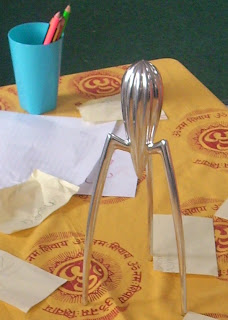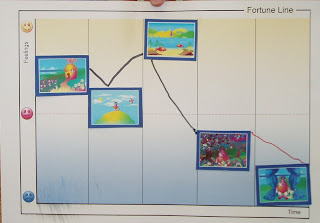 Now that there are 15 schools and nurseries in Norway in the Community Designed Education network, with 6 more due to join this summer, I thought it about time I posted a Norwegian blog (for the English version, use the translator at the bottom of the page). And how fitting that the picture should come from Hogsnes oppvekstsenter, the first school in Norway, and indeed in Scandinavia, to join the CDE network.
Now that there are 15 schools and nurseries in Norway in the Community Designed Education network, with 6 more due to join this summer, I thought it about time I posted a Norwegian blog (for the English version, use the translator at the bottom of the page). And how fitting that the picture should come from Hogsnes oppvekstsenter, the first school in Norway, and indeed in Scandinavia, to join the CDE network.
Sentralt i CDE-prosessen står undervisning av de mentale modellene som er nødvendige for å virkeliggjøre skolens (eller barnehagens) visjon. Mentale modeller er de dypt forankrede antakelser, generaliseringer eller bilder vi har, som avgjør hvordan vi forstår verden, og hvilke valg vi gjør, hvilken praksis vi velger.
For eksempel, hvis en lærer mener at barn lærer best hvis de får motta informasjon som de siden skal huske, vil denne læreren legge opp sin undervisning ut fra det. En annen
lærer, som mener at barn lærer best når de får stille spørsmål, tenke gjennom sine begrunnelser og trekke sine egne konklusjoner, vil gjennomføre en helt annen type undervisning. Begge disse lærerne handler ut fra god tro, ut fra en tro på at deres praksis gir gode muligheter for læring, men de befinner seg i svært forskjellige virkeligheter. Dette er grunnen til at mentale modeller har så stor betydning, og grunnen til at de "riktige" mentale modeller må identifiseres og undervises i, hvis skolen (eller barnehagen) skal kunne realisere sin felles visjon.
Da personalet ved Hogsnes Oppvekstsenter skulle identifisere de mentale modellene som var nødvendige for at de skulle kunne realisere visjonen sin, gjennomførte de først en brainstorming. Deretter stemte de fram de viktigste, blant de mentale modellene de hadde identifisert ut fra visjonen sin. (Resultatet kan dere se på bildet.) Utfordringen deres ble deretter å modellere, snakke om å undervise i disse mentale modellene, hver dag, med alle medlemmene i læringsfellesskapet.
Det gleder meg å kunne si at de har gjort store fremskritt! Faktisk så store at Ragnhild Isachsen, rektor på Hogsnes, er invitert til å holde et foredrag (keynote speech!) på den 14.Internasjonale Tenkekonferansen i Kuala Lumpur neste måned!
 One of the frameworks I regularly share with teachers is that of the Learning Pit, a model that explains how and why challenge is necessary for learning. Having first heard Dr John Edwards in 2001 using a "pit" to explain how organisational growth more often than not involves getting worse before getting better, I thought that the metaphor was an ideal way to explain to my students why I was consistently making things more difficult for them. Since then I have developed the idea into the following four-stage lesson plan:
One of the frameworks I regularly share with teachers is that of the Learning Pit, a model that explains how and why challenge is necessary for learning. Having first heard Dr John Edwards in 2001 using a "pit" to explain how organisational growth more often than not involves getting worse before getting better, I thought that the metaphor was an ideal way to explain to my students why I was consistently making things more difficult for them. Since then I have developed the idea into the following four-stage lesson plan:
























